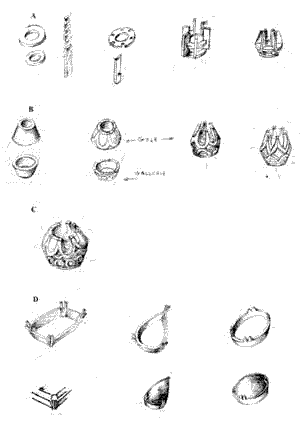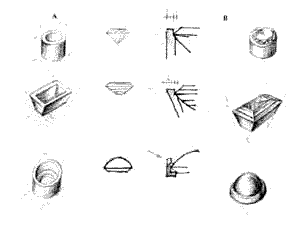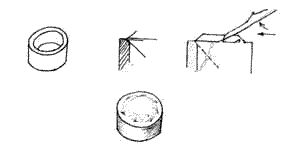|
|||||||||||||||||||||||||||
|
|||||||||||||
 |
|||||||||||||
|
The griffe besides the fact that it's built with wire it's also created in plate with 4,6,8 points with metal grooves between the points disposed so that a riflextion of light is obtained and this enlarges the stone (dis. A-B-C). The effect is heavier than the wire one,but the safety of the stone is greater. The griffe and the setting with double points are used for the central stones of the rings and in some centres of necklaces of great dimensions (dis. E). Sometimes the points have smoother gold especially for emeralds or are in platinum for diamonds, this avoids that the stones gets marked. The first ring of the griffe or the first are yellow gold to mantain the colour of the stone better and in special cases its inside will result more or less shiny so that it mitigates certain imperfections of the colour. The double points are used even when the stone isn't regular or symmetrical and this type of embedding mitigates its imperfection that would show if other types of embedding were used.
|
|||||||||||||
 |
|||||||||||||
|
English setting
The English setting is a continuous circular support around the stone, which has a metal border also continuous that keeps it still. Once the stone is arranged inside the setting (dis. A) for about half the thickness of the border, it is bent with a hammer against the stone so that it blocks it (dis. B) and then levigated leaving the border shiny. This embedding isn't advisable because the angles could break for the pressure. It is used in prevalence for rings and bracelets because it avoids those troubles of entanglements that come out with other types of embeddings. |
|||||||||||||
|
Moustache embedding
The moustache embedding is used in alternative to the English one, that always covers the stones a bit. The stone is fixed in the setting and it is stopped with metal curls (moustache) and are obtained with the burin (engraver) on the border that surrounds the stone. It will be appropriate to use this type of embedding with small stones not subjected to rubbing, for the little meccanic resistance of the moustache (dis. A). It is used sometimes even on "pave'" surfaces or on metal tapes (you can notice this especially on antique objects) |
|||||||||||||
 |
|||||||||||||